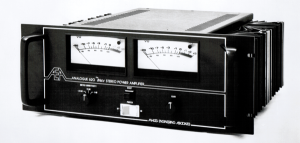AEA was the first to break the 1000 watt per channel barrier:
One of the most important requirements for high quality sound reproduction is plenty of “head room” in the power amp. All amplifiers increase their distortion as the output level increases. This holds true in preamps as well as power amps, but is especially noticeable in power amps.
Because to the extreme dynamic range of music, a great deal of power can be required during brief periods of peaks in sound level. Music often requires the amplifier to produce up to 1000 times more power on peaks than on quiet passages. This is because a doubling of perceived sound volume requires 10 times more power (a 10 dBm increase). To do this at the high power required by many modern speaker designs, and still remain well below the amp’s maximum rating, requires enormous power reserves. Most amps simply “run out of steam” on those peaks when played at high sound levels. The result is often described as a bit “bright” or “shrill” sounding on loud peaks… not something you want in a high-end sound system.
To meet this challenge AEA had to overcome the limits of solid state technology at that time… and by a wide margin. And we did— through another technical breakthrough. This time with a completely new type of solid state power output stage.
The AEA 620 was the first commercially available power amp to use a four quadrant bridging output stage, also referred to as a Diamond Configuration. Each channel consists of eight bipolar transistors. On the left-hand side—the signal-input side— a matched pair of PNP transistors, and, below it, a matched pair NPN transistors, tied together at their bases; and, on the right-hand or signal-output side, a matched pair of NPN transistors and, below that, a matched pair of PNP transistors, having their emitters tied together. The emitters of the left-hand transistors are tied to the bases of the adjacent right-hand transistors, and the collectors are biased all around: negatively in the case of the PNPs, positively for the NPNs. When the circuit is drawn in the manner described, with connecting nodes at North, South, East, and West, the schematic assumes a diamond shape, hence the name Diamond.
This unique technical innovation allowed AEA to surpass the existing technical limitations of output power due to the voltage limits of power transistors of that era.
Along with its huge power handling capacity this innovation has a number of other strengths:
It operates in a floating- or above-ground condition with considerable power gain. It’s reliable, and perhaps best of all, the diamond circuit is simple, resulting in lower transient distortion products.
The result was a rugged, extremely low distortion amplifier with far more power per channel than any other amp of that period was capable of with plenty of “head room” for everything from outdoor rock concerts to the most demanding audiophile’s living room.

